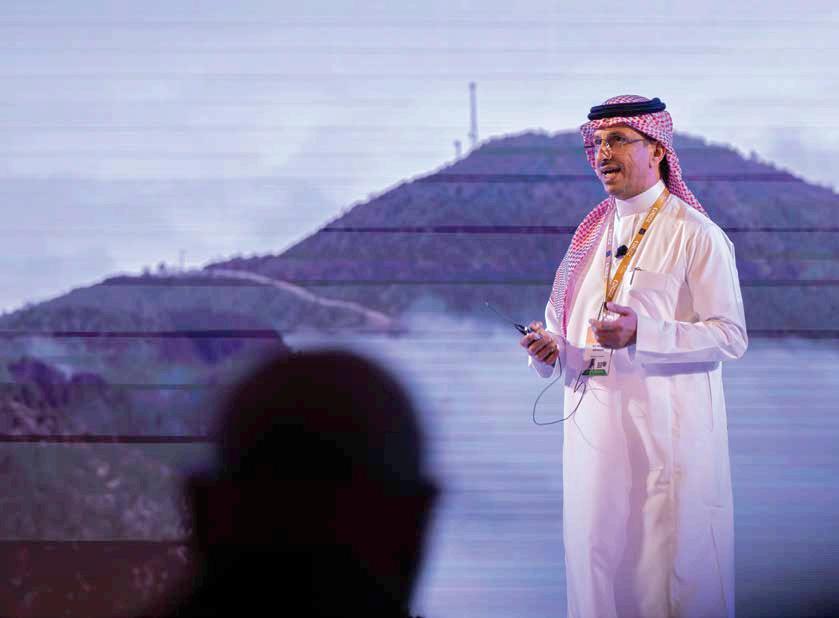
20 minute read
WELCOME, WORLD
WORDS VARUN GODINHO
The annual World Travel and Tourism Council’s Global Summit held in Riyadh recently showcased not only the stellar recovery that the industry has made, but also the roadmap for a promising future in the short- to mid-term

Only a few months ago, alarm sirens wailed as the World Travel and Tourism Council (WTTC) stated that the travel and tourism sector had taken a US$4.5 trillion hit in 2020 due to the Covid-19 pandemic. At the time, its contribution to global
GDP dropped 50.4 per cent, vastly disproportionate to the 3.7 per cent dip in the overall economy globally.
Legitimate questions about the robustness of the sector swirled.
However, at the 22nd Global
Summit of the WTTC held at the
King Abdul Aziz International
Conference Centre in Riyadh from
November 28 - December 1 last year, it was clear that all that pessimism from only a few months prior had dissolved to give way to buoyant celebration as the industry made a charging comeback.
Julia Simpson, WTTC president and CEO, took to the stage at the opening of the summit, to outline the prospects of that recovery. “When travel and tourism thrive, other industries thrive with it. Our ten-year forecast shows that our sector will outpace global growth. We will be growing at 5.8 per cent annually, while global GDP is expected to grow at 2.7 per cent.”
Ahmed Al Khateeb, Saudi Arabia’s Minister of Tourism, spoke on that same stage just before Simpson and called for “collective action” to build out the future of the industry. “We have to future-proof this industry that provides one in nine jobs. Tourism will create 126 million new jobs in the next decade – that means one in every three new jobs created will be in our sector. It means we can change many lives, if we do this right.”
Al Khateeb’s remarks were being made in a country that was indeed doing it right. As recently as a decade ago, tourism wasn’t a major consideration for Saudi Arabia. But as an aggressive national economic diversi cation agenda took root, it became among the kingdom’s core agendas with giga projects currently being executed around the country.
At the summit, one of those giga projects – the US$50.6 billion mixeduse development at Diriyah on the outskirts of Riyadh – announced the opening of At-Turaif, the UNESCO World Heritage Site at Diriyah, as well as its adjacent premium dining destination of Bujairi Terrace.
Another major announcement that coincided with the summit was the unveiling of a master plan for a new
ABOVE: Ahmed Al Khateeb, Saudi Arabia’s Minister of Tourism BELOW: Panel discussions at the WTTC Global Summit 2022
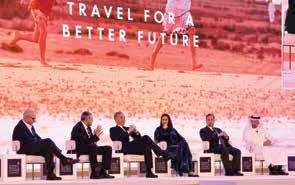
six-runway King Salman International Airport which will be built in Riyadh to accommodate up to 120 million travellers by 2030. e con dence that the industry as a whole has in the future of Saudi was only reiterated when Simpson revealed that WTTC members are set to invest more than US$10.5 billion in the kingdom. e calibre of speakers who took to the stage over the course of the summit is enough to convince you about the collective might of those WTTC members. Six of the world’s biggest operators – Hilton, Marriott International, Hyatt Hotels Corporation, Accor, IHG and the Radisson Hotel Group – had their CEOs present at the summit in Riyadh. Hilton President and CEO and former chairman of WTTC, Chris Nassetta, was joined by the CEO of the world’s largest hotel group, Anthony Capuano of Marriott International. Hyatt Hotels Corporation president and CEO Mark Hoplamazian, IHG CEO Keith Barr, Accor chairman and CEO Sébastien Bazin, and Radisson Hotel Group CEO Federico J González too showed up in Riyadh. Together, these six major brands are reported to manage over four million hotel rooms around the world. Collectively, they are reported to have around 43,500 new hotel rooms in the pipeline for Saudi Arabia. e summit, held under the theme of ‘Travel for a Better Future’, saw the participation of over 3,000 delegates from 140 countries. e Riyadh gathering had double the number of delegates compared to the previous pre-Covid WTTC summit in Seville, and also had nearly three times as many countries represented within it. Drawing in the crowds at the WTTC were speakers including Ban Ki Moon, who served as the eighth UN Secretary-General from 2007 to 2016, as well as former UK Prime Minister Lady eresa May. ey had the full attention of the approximately 55 government ministers, over 250 CEOs and more than 60 ambassadors and diplomats who attended the summit. WTTC’S CITIES ECONOMIC IMPACT 2022 REPORT
US$1.1 trillion
Combined direct travel and tourism contribution in the 82 surveyed cities by 2032
US$29.4 billion
International visitor spending in Dubai in 2022
25.2 million
Forecasted number of direct travel and tourism jobs in the 82 cities by 2032
+21%
The percentage increase in international visitor spending in Doha in 2022 compared to 2019
SUSTAINABILITY MATTERS
Among the numerous panel discussions and interviews conducted during the summit, it included e Global Business of Travel, Accelerating the Energy Transition, and Investing in Mega Events.
However, the most dominant theme of all was that of sustainability.
BELOW: Former UN Secretary-General Ban Ki Moon speaks at the summit in Riyadh In 2019, transport accounted for 38 per cent of emissions. While stakeholders have rushed to address the issue of sustainability, not many are fully aware of the actual impact and climate footprint of the global travel and tourism industry. At the summit, the WTTC released the data of its Environmental and Social Research report, which details the climate footprint of the global travel and tourism sector. WTTC said that its research accurately tracks the impact that various participants of this sector have on the environment. e data covers 185 countries and will be updated annually. e inaugural report stated that while previous estimates suggested that the global travel and tourism sector was responsible for up to 11 per cent of all emissions, WTTC’s research instead shows that in 2019 the sector’s greenhouse gas emissions totalled 8.1 per cent worldwide. It noted that the emissions were falling consistently since 2010 and attributed it to technological developments coupled with energy e ciency measures across industries. Between 2010 and 2019, the sector’s GDP
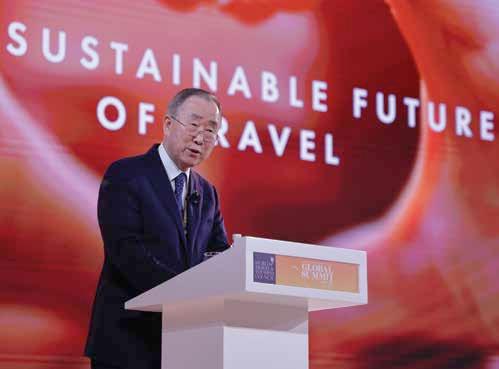
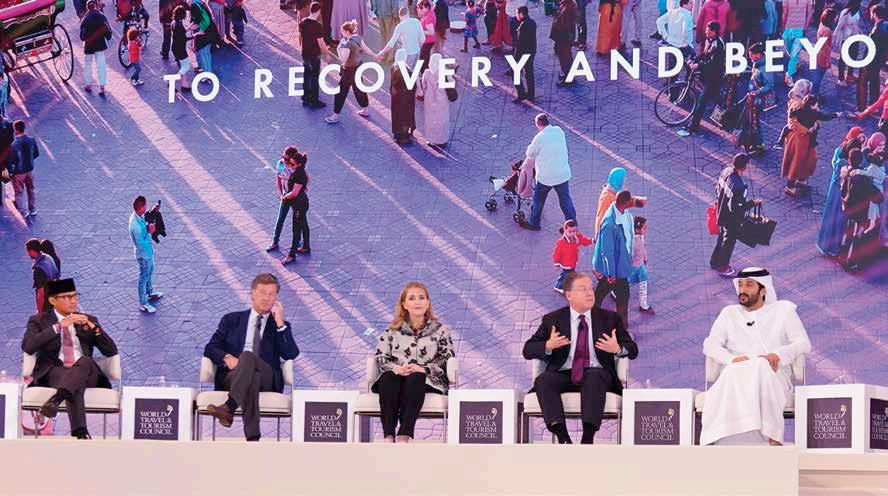
grew on average 4.3 per cent annually whilst its environmental footprint increased by 2.4 per cent.
“Now we know what we are working with. We can compare where we are today to where we were ten years ago. We can track not just greenhouse gases, but everything from energy consumption to water usage. It will give our businesses, the data they require to understand where they need to focus and it will also give governments hard facts on how to meet ESG targets. The great dream here is decoupling growth in travel and tourism from carbon emissions,” said Simpson.
A focus on sustainability isn’t just a moral and social imperative, but an economic reality too. As Simpson noted, “The WTTC’s Nature Positive Travel and Tourism report shows that tourism from nature generates over US$600 billion, and that creates opportunities for the world’s poorest countries to protect their biodiversity and their communities. In Rwanda, for example, tourism is the largest source of foreign exchange earnings invested back into the country.” turn funnels 100 per cent of profits back into the community’s health and conservation services.
Another major sustainabilitylinked report released at the WTTC – Better Travel and Tourism, Better World – developed through a partnership between the Saudi-based
126
MILLION
Total new travel and tourism jobs globally by 2032
5.8%
Forecasted annual growth of the travel and tourism sector over the next decade
Actor Edward Norton, UN Goodwill Ambassador for Biodiversity, took to the stage at the summit too. Norton has played an important role in conservation financing models which range from forest carbon project development to a new ‘impact capital’ facility for luxury tourism which in
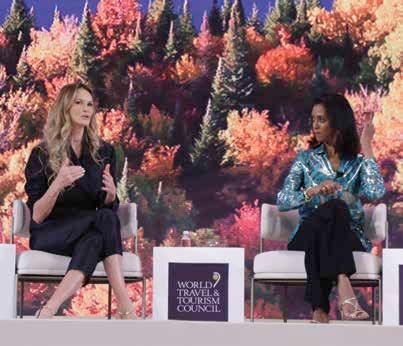

Sustainable Tourism Global Centre (STGC) and independent system change advisory firm Systemiq, found that the travel and tourism industry could reduce its emissions by over 40 per cent by 2030 though drastic action. It cautioned that left unchecked, these emissions will rise 20 per cent by 2030. The report is also believed to be the first to estimate a fully-costed roadmap to decrease emissions in the industry to steer it towards a net-positive model by 2050. It states that the sector would require increased investments of US$220-310 billion a year to 2030, equating to two-three per cent of the industry’s overall US$10 trillion contribution to the world’s GDP. The report calls for reform measures to focus on five major priorities: reducing emissions, protecting and restoring nature, strengthening communities, shifting traveller behaviours and increasing resilience to climate change.
THE PATH TO GROWTH
As the conference drew to a close in Riyadh – a city that aspires to be one of the world’s top 10 city economies by 2030 – the findings of another significant report were released. The WTTC’s Cities Economic Impact 2022 Report, surveyed 82 cities around the world to find that ten of them were projected to surpass pre-pandemic levels in terms of direct travel and tourism contribution to their GDP in 2022. From the 82 cities combined, direct travel and tourism contribution to GDP in 2019 stood at US$734 billion, and was forecast to hit US$582 billion in 2022 and US$1.1 trillion by 2032. “In the decade to come, cities will continue to grow. Growth in travel and tourism GDP will continue to grow with it. This is particularly the case in Asia-Pacific and the Middle East, which will witness unprecedented growth,” Simpson stated in the report.
The Middle East’s status as a front-runner is evident when you consider that the contribution of travel and tourism to Doha’s GDP in 2022 was expected to increase 21 per cent over 2019 levels – the highest increase among the 82 cities covered in the report. Two other Middle East cities – Dubai and Doha – also came out ahead when it came to expected international tourist spending for 2022. International visitor spending in Dubai was forecast to reach US$29.4 billion in 2022, and followed by Doha in the second position at US$16.8 billion. Travel and tourism are also expected to be an engine of job creation in those 82 cities. Over the coming decade, the report states, the sector will directly generate up to eight per cent of all jobs in these cities combined – up from 6.6 per cent in 2019.
The private sector will undoubtedly play a major role in that growth. Princess Haifa Al Saud, Saudi Arabia’s Vice Minister of Tourism, pointed out during a panel discussion at the summit in Riyadh, that while the government has been proactive in building out its tourism portfolio – she says the Saudi’s tourism development council has 20 government representatives at a ministerial level to ensure delivery with clear KPIs in place – the private sector is being actively courted too. “When we launched the initiatives to deal with the pandemic, we sat down at the table with the private sector and heard from them. We are amending our policies – for example, the criteria for hotel classifications – with the private sector. We had over 1,000 sittings with them this year alone and we’ve heard from them that one size doesn’t fit all, so we’re amending it accordingly based on their feedback. We have 28 initiatives that we will be launching to facilitate the investor journey.”
She added, “In the government, we have the mindset of transforming our economy as a whole. We need to be willing to learn, to see what worked, and what didn’t…and continue to develop what we need to do further.” As the WTTC summit in Riyadh demonstrated, what is true for Saudi Arabia, is true for the rest of the world’s travel and tourism industry.
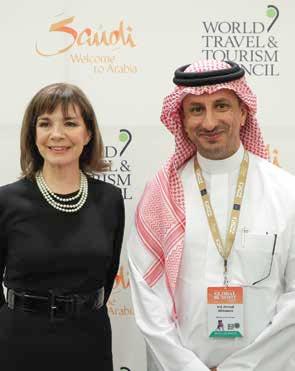
JULIA SIMPSON, WTTC president and CEO
CLOCKWISE FROM
ABOVE: Julia Simpson and Ahmad Al Khateeb; Elle Macpherson with Zeinab Badawi; A panel moderated by Richard Quest
Beyond the
The Jumeirah Gulf of Bahrain Resort and Spa opens up the country’s hospitality industry to a new level of luxury
WORDS VARUN GODINHO
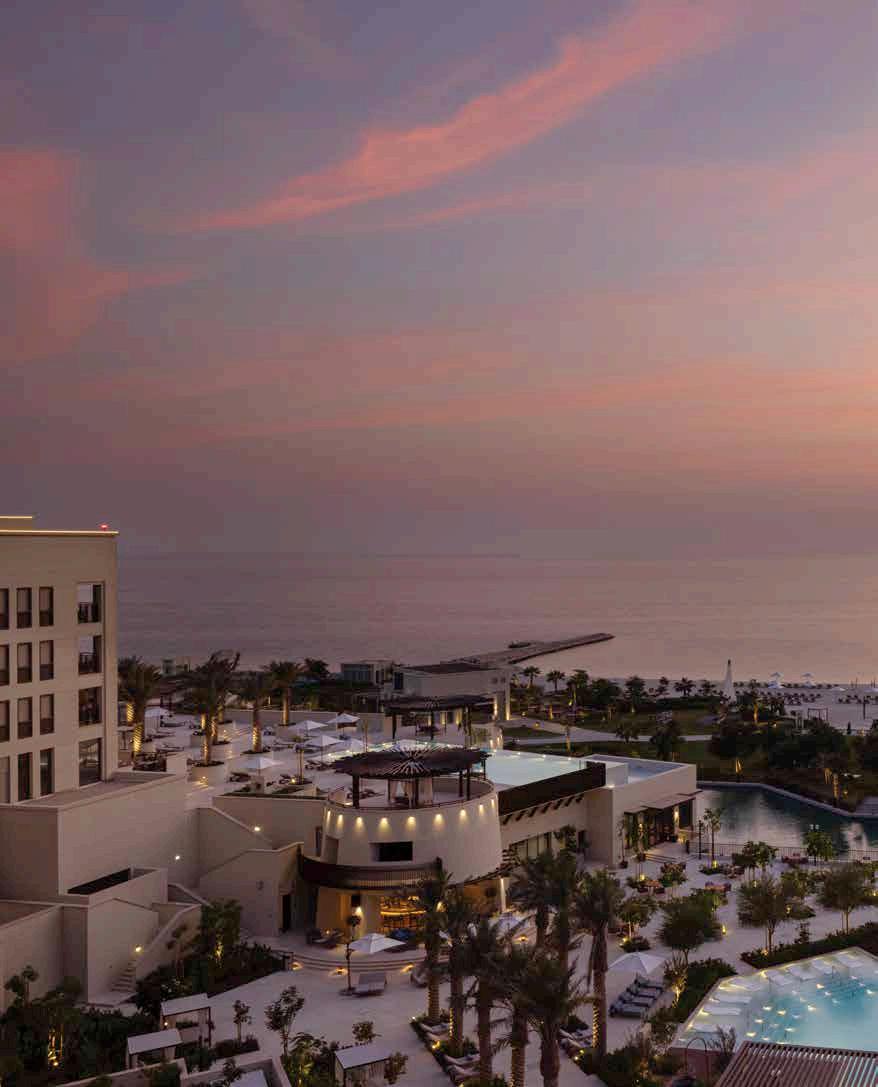
Over the rst three quarters of 2022, Bahrain’s Economic Development Board attracted US$291 million in direct investments in the tourism sector. e investments, it added, was by way of eight companies which are either expanding or entering Bahrain for the very rst time. ose investments in turn are expected to generate 1,090 jobs over the next three years. at determined push in tourism is explained when you consider that the kingdom’s 2022-2026 tourism strategy aims to attract 14.1 million tourists by 2026. e country’s stated goals to increase the contribution of tourism to GDP are centred around four objectives: to increase the contribution of tourism to GDP to reach 11.4 per cent in 2026; increase the number of targeted countries to attract more tourists; highlight Bahrain’s position as a global tourist hub; and diversify its tourism products.
While Bahrain is reported to be investing over US$10 billion into infrastructure projects to support its tourism industry, large hotel groups are turning their attention to the kingdom.
Among them is the UAE-headquartered Jumeirah Group, a member of Dubai Holding, and a company that has a portfolio of over 6,500 keys in 26 luxury properties across the Middle East, Europe and Asia.
In November, it opened the stunning new Jumeirah Gulf of
Bahrain Resort and Spa located along the kingdom’s west coast. e property boasts 196 rooms and suites across several categories. e 44 sqm Deluxe Room is available with either a king-size bed or twin beds and can accommodate two adults and two children. An Ocean Deluxe Room allows views of the azure waters along the horizon from its private balcony. For larger families, there’s the 55 sqm Family Room that can accommodate up to three adults and has a walk-in wardrobe, sitting area and two TV screens. e suites meanwhile are a step up in the resort’s accommodation o erings. e 93 sqm Resort Suite has a large private balcony, a separate living area, a chaise lounge and dining area, a bathroom with a separate bath and rain shower and a bedroom with a sitting area too. e Ocean Suite o ers all of that, with the additional bene t of views looking out over the sea. e Ocean Terrace Suite trades in the balcony for a terrace where guests can order in-room breakfasts. Staying at any suite in this resort allows you to gain a host of bene ts including co ee machines in the room, a minibar and a pillow menu too for a restful night’s sleep. Importantly, staying at any suite also allows guests to avail of complimentary airport transfers, bu et breakfasts and sundowners, as well as the option of an early check-in and a late check-out.
For the ultimate accommodation option at the property, you could opt for the 11-bedroom Gulf Summer House, located on the beach.

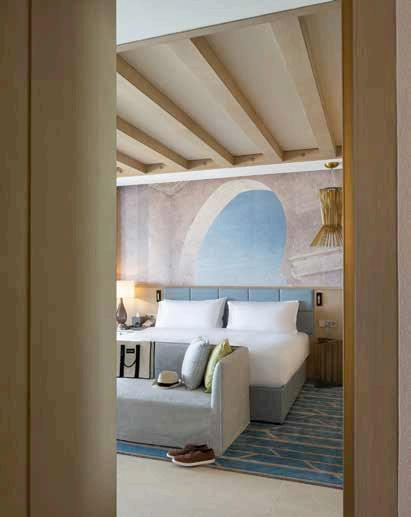
20
Curated culinary experiences
Beyond luxury accommodation, the culinary offerings at Jumeirah properties worldwide are noteworthy. The Jumeirah Group has more than 85 restaurants across its portfolio, including homegrown concepts such as Sal, Kayto, Shimmers, Al Mare, Pierchic and French Riviera. There’s external validation for the group’s culinary bastions too – ten of its restaurants are featured in the Gault&Millau UAE 2022 guide, while three – Shang High, L’Olivo and Al Muntaha – were awarded Michelin stars as well.
In Bahrain, Jumeirah has maintained an eclectic mix of food and beverage options to cater to its diverse international guests.
Obab Al Bahar has an à la carte menu as well as a daily buffet. Its creations span Europe, the Middle East, East Asia and India. The restaurant also features a beverage menu that it says is “infused with local ingredients, fragrances and spices to deliver a unique Bahraini experience.”
Open for lunch and dinner is the Sicilian restaurant Due Mari which serves homemade pasta, pizzas, salads and, of course, gelatos, on the alfresco private terrace located alongside the pool.
For great views of the sun going down over the sea, head to Al Sama which is open from 5pm until 1am daily. It not only has an extensive beverage menu, but also has a shisha menu. Meanwhile, the resort’s lobby lounge, Majlis Al Fijiri, allows guests to sample handcrafted chocolates and local pastries created by the hotel’s resident pastry chef.
The resort will soon be opening the uniquely named 25 | 50 bar whose design is inspired by Bahraini boats and will serve tapas and seafood options, alongside a mixologist who will tend to all the beverage requests. Ousoul, also opening soon, will be located along the beachfront and serve cocktails and juices. For those searching for an authentic Middle Eastern experience, Maison Fayruz delivering Lebanese and Levantine preparations, is also expected to open soon.
Wellness and amenities
Wellness is a major focus of the new resort and one that the general manager at the property has focussed on extensively. “We are passionate about wellness, and I am confident that with Jumeirah’s renowned hospitality expertise and the luxurious experiences on offer – and, of course, the resort’s unique beachside location – our guests will walk away feeling revived and refreshed from their stay with us,” said Marco Den Ouden, general manager of Jumeirah Gulf of Bahrain Resort and Spa. Ouden is a veteran in the hospitality industry having worked at several properties around the world including in London, China, the Netherlands, Singapore, Indonesia and Maldives. He has been instrumental in overseeing operations for five-star luxury resorts and city hotels. Prior to joining Jumeirah Group, he held the role of cluster general manager at Patina and Capella.
This new property in Bahrain has wide-ranging wellness offerings. Talise Spa includes 13 treatment rooms – including six female-only and six male-only treatment rooms – as well as a couple’s treatment room with its private hammam, bubble bath and relaxation area. “We are working towards making 90 per cent of our spa filled with our handmade offerings including the oils, scrubs, mignardises, detox drinks and hot tea. There are four key ingredients that you will find in the drinks, oils, mignardises and scrubs,” says Celine Fontenay, Spa and Recreation director at the resort.
The treatments offered here vary from prenatal massages to a four-hands massage where two therapists simultaneously provide a synchronised massage. Another option is the Talise Treatment which lasts for nearly three hours and is perhaps the most extravagant one. Two individuals are covered under this treatment and it includes a body scrub, followed by a 60-minute body massage and capped with a facial treatment. CLOCKWISE FROM The indulgent massage isn’t complete without TOP LEFT: Ocean Suite bedroom; Arabian Suite complimentary glasses of champagne. “We are also building some well-being and with a private sports programmes that combine meal plans, pool; a sitting area; Talise Spa sports, spa, yoga, sophrology and naturopathy,” Turkish Bath adds Fontenay.
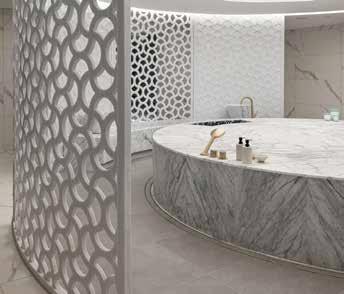
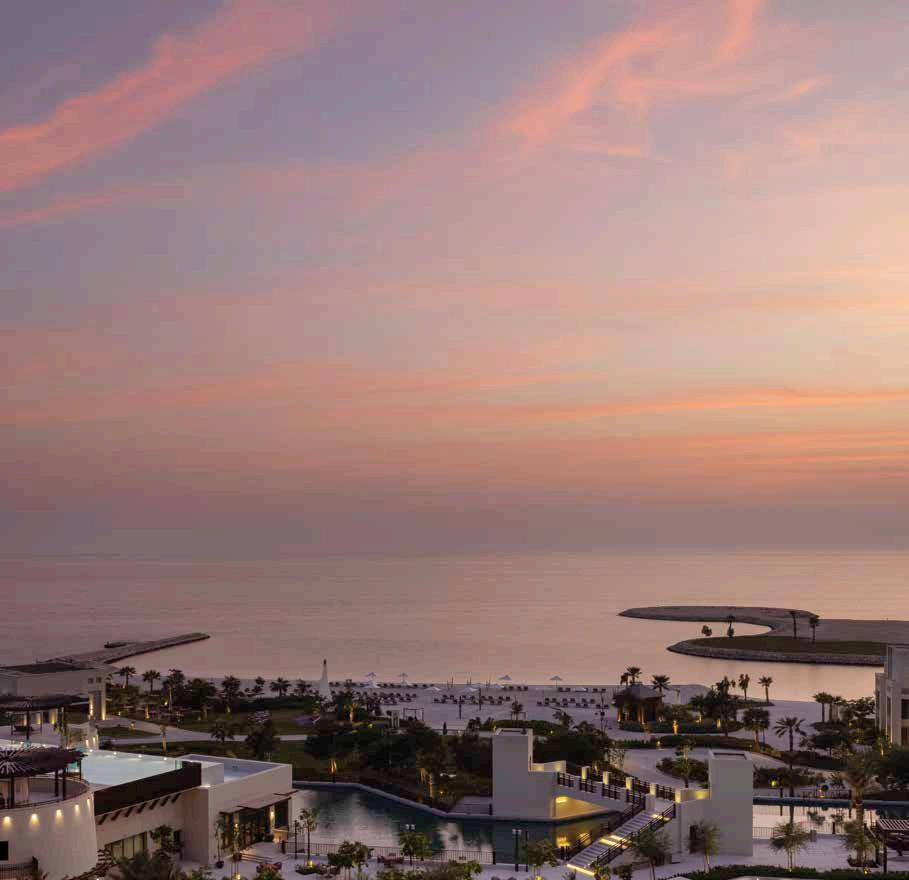
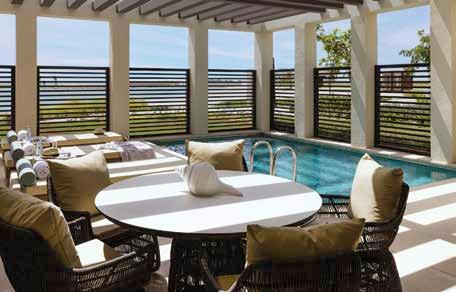
Personal trainers are on-hand at the property to offer their services at Society 989’s Technogym-equipped gym and offer packages for 5-20 sessions. “By bringing in the InBody 270 body composition machine which has an accuracy of 95 per cent, it can not only measure weight, but also body fat, muscle mass, water weight and fat-free mass. We work with Technogym to use their online platform to help guests stay on top of their fitness goals through its Mywellness App. This means, regardless if they are frequent travellers or our regular guests, they’ll be able to track their workouts as long as they scan the QR code on the Technogym machines that they are using. They’ll be able to store and track their body composition results via the app to see how much progress they have made. I’ll also be able to plan and assign tailored workout programmes for our guests and clients to help keep them on top of their workout goals,” says Daniel Badu, Membership and Fitness manager at the Jumeirah property.
For those who want an extended personal training package, the trainers also deliver a 16-week package that includes a total of 48 sessions, offered thrice weekly. “The 16week transformation package is more designed for locals. This will be a tailored package to help clients change their views about training and nutrition, and transform their bodies. Whether it is to lose fat, build muscle, or just to help them live a healthier lifestyle, the focus here will be to build sustainable eating and physical activity habits for individuals while also educating them on their journey,” notes Badu.
Other sports amenities at the resort include a squash and multipurpose tennis court. Sports will also be a big focus area for the resort. “We are building a water sports area to bring exciting, non-motorised sports to the resort. We will also be bringing in a football academy that focuses on kids and teens. Soon, we will be starting yoga and Pilates classes to help individuals improve their mobility and increase flexibility too. We will also be hosting football sessions for visiting kids and teens who want to develop their skills with top UEFA coaches who have experience
training professional football clubs. We will also offer a three-in-one experience that includes tailored workouts or sports activities such as tennis, basketball or squash, personalised meal plans developed by our head chef depending on the client’s goals of either weight loss or improving their skin or raising their We are passionate energy levels, and all of this will be coupled with about wellness. Our a personalised spa treatment to help with recovery guests will walk away and mobility,” adds Badu. feeling revived and There are multiple pool options at the property refreshed. including a temperature-controlled indoor pool and MARCO DEN OUDEN, an outdoor adult’s-only pool. This being a familygeneral manager of Jumeirah Gulf of Bahrain Resort and Spa centric resort, there’s a kid’s club featuring a pool, play area and nap room, Teen’s Club and a family pool too with a slide. There’s a 36-seater cinema on the property as well. The resort’s events facilities include a conference and events centre, board meeting rooms and two ballrooms that can accommodate up to 160 people. The outdoor space at the resort can also be used for larger gatherings and can accommodate up to 500 people.
Jumeirah on the rise
Change is underway at Jumeirah. Dubai Holding announced that as of December 2022, Katerina Giannouka was appointed as the chief executive officer of Jumeirah Group. Giannouka brings to the table more than two decades of experience across multiple aspects of the hospitality industry including operations, hotel development as well as asset management. According to research commissioned by Arabian Travel Market (ATM), and conducted at the end of September 2022 by hotel market intelligence company STR, the GCC region now has over 170,000 hotel rooms under active development. The report added that this is equivalent to 40 per cent of the GCC’s existing hotel room inventory, almost four times more than the rest of the world which currently stands at an average of 11 per cent under active development compared with its existing supply. This makes Giannouka’s role in the Jumeirah Group and her focus on the region all the more vital. In July last year, Jumeirah opened its first hotel in Oman in the country’s capital of Muscat. Another major upcoming regional opening for the group is the Jumeirah Marsa Al Arab in Dubai which is expected to open this year. In the interim period, those who want to sample what to expect from upcoming luxury Jumeirah properties globally would do well to check in to the Bahrain resort immediately.











